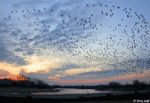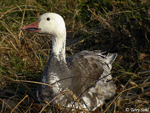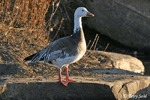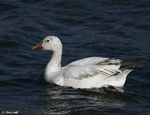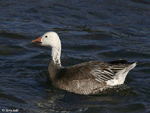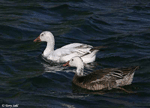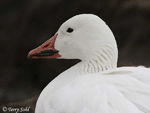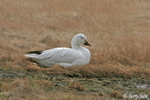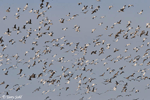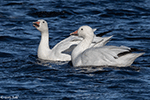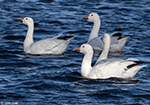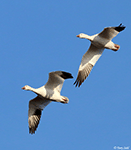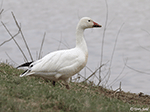| Length: 28 inches | Wingspan: 55 inches | Seasonality: Migrant |
| ID Keys: White morph has white body and wings with black primaries, dark morph have a white head and neck with a bluish gray body. Distinct "grinning patch" on the beak. Compare to Ross's Goose. | ||
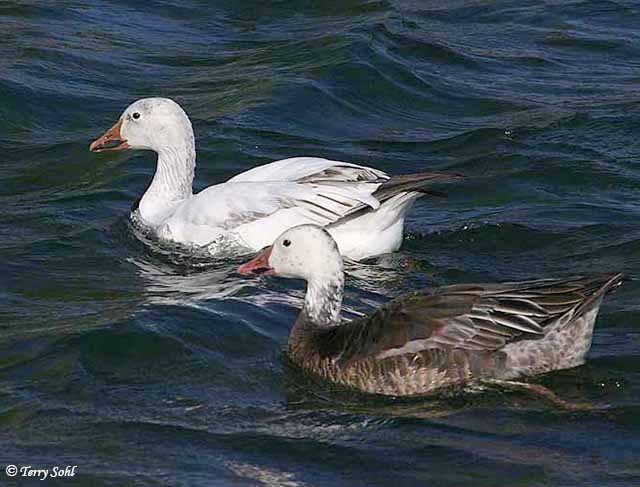 Once considered two
separate species, the Snow Goose and the Blue Goose are now considered white and
dark morphs of one species, the Snow Goose. The two morphs readily
interbreed and may produce offspring of either morph. Note Ross's Goose
is very similar to the Snow Goose, with the primary difference being a
smaller size for the Ross's. Hunted to extremely low populations
by the start of the 1900's, huge migrations of Snow Geese now make their way
through the state, stopping at traditional locations including the lakes
around Lake Thompson in Kingsbury County and Sand Lake in Brown County.
A photo of a white and dark morph swimming together is shown on the right.
Once considered two
separate species, the Snow Goose and the Blue Goose are now considered white and
dark morphs of one species, the Snow Goose. The two morphs readily
interbreed and may produce offspring of either morph. Note Ross's Goose
is very similar to the Snow Goose, with the primary difference being a
smaller size for the Ross's. Hunted to extremely low populations
by the start of the 1900's, huge migrations of Snow Geese now make their way
through the state, stopping at traditional locations including the lakes
around Lake Thompson in Kingsbury County and Sand Lake in Brown County.
A photo of a white and dark morph swimming together is shown on the right.
Habitat:
In migration through the state, found on shallow lakes, marshes, and flooded fields. Often feeds on waste grain in agricultural fields.
Diet:
Snow Geese are almost exclusively vegetarian, although very young hatchlings may sometimes feed on small invertebrates. The diet may consist of seeds, waste grain, leaves, roots, grasses, aquatic vegetation, and berries. Waste grain forms a large part of the winter diet, with winter behaviors and overwintering locations that may depart from historical norms due to the widespread availability of this new food source.
Behavior:
Except during the breeding season, Snow Geese are very gregarious, forming large flocks that sometimes include other goose species. Foraging is primarily done by walking through shallow water or on land.
Breeding:
Non-breeder in South Dakota. On their Arctic breeding grounds, Snow Geese are loosely colonial, with spaced nesting sites that may consist of many hundreds of pairs. Individual pairs typically mate for life. The nest itself is built on tundra vegetation, often in a protected spot if available. The nest is a scrape in the ground, lined with down from the female. However, in areas where nesting is on more open ground, the nest may also consist of grasses, mosses, and willow stems. The female lays between 2 and 6 eggs. She alone incubates them, but the male is often nearby to help protect the nest. Incubation lasts about 3 weeks. The young leave the nest soon after hatching, and are tended to and protected by both parents.
Song:
1Click here to hear the calls of a large flock of Snow Geese
Migration:
Summers in or near the Arctic Circle, winters in scattered locations through the United States and Mexico. Snow Geese generally winter in areas further south than South Dakota. However, depending upon the severity of the winter weather, the availability of open water, and availability of harvested crop fields from which they can feed on waste grain, Snow Geese may stay into early winter in the state or even attempt to overwinter.
Interactive eBird Map:
Click here to access an interactive eBird map of Snow Goose sightings
Similar Species:
- Ross's Goose. Click here for identification tips for Snow and Ross's Goose. Both are often found together as they migrate through the state. While it may be difficult to identify the two species if seen from a distance, or if just one of the two species is present, overall size, and bill, are the two easiest ways to differentiate between Ross's Geese and Snow Geese. Snow Geese have the more robust, longer bill, with the characteristic dark "grinning patch". Ross's Geese lack the grinning patch, have a shorter, stubbier bill, and have a base of the bill that is usually "warty". If seen together Snow Geese are considerably larger than Ross's Geese.
- Greater White-fronted Goose - A white Snow Goose isn't likely to be confused with the darker plumaged Greater White-fronted Goose, but a darker "blue" Snow Goose could be. Both have grayish upperpaarts, a white lower belly, and a banded pattern on the flanks. However, a Greater White-fronted Goose has a gray head and neck with a white patch where the bill meets the face, while a dark Snow Goose has a white head and upper neck. The white on a Greater White-fronted Goose is restricted to the lower belly and undertail, while white is more extensive on the underparts of a dark Snow Goose. Legs on a Greater White-fronted Goose are orange, while they are pink on a Snow Goose.
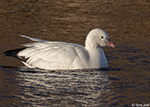 |
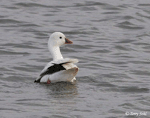 |
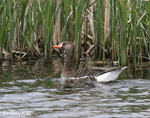 |
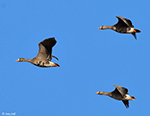 |
| Ross's Goose | Ross's Goose | Greater White-fronted Goose | Greater White-fronted Goose |
Conservation Status:
The total population of Snow Geese was reduced to only a few thousand by 1900. It has made a tremendous comeback, to the point that overpopulation of Snow Geese on summer breeding grounds is causing localized habitat destruction. Many states now have very relaxed hunting regulations for Snow Geese or extra, special seasons in an effort to reduce numbers. Numbers continue to increase, however. Given the very large population and geographic range of the species, the IUCN lists the Snow Goose as a species of "Least Concern".
South Dakota "Hotspot":
Thousands of Snow Goose regularly use Sand Lake in Brown County during migration to and from their summer breeding grounds. During the peak of migration, however, Snow Geese are often relatively easy to find throughout much of South Dakota. They're just as likely to be found foraging in agricultural fields as they are on bodies of water, particularly during the daylight hours as they feed.
Further Information:
Photo Information:
Minnehaha County - Terry Sohl
Additional Photos:
Click on the image chips or text links below for additional, higher-resolution Snow Goose photos.
Audio File Credits:
1Peter Ward and Ken Hali. November 25th, 1983 in Vancouver, British Columbia. Original recording and information available from xeno-canto.
| Click on the range map for a higher-resolution view |
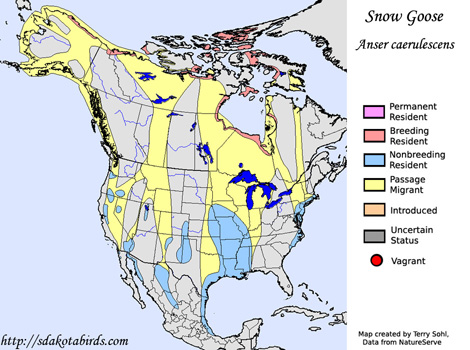 |
| South Dakota Status: Common migrant with higher concentrations in the eastern part of the state. Rare in winter. |
Additional Snow Goose Photos
Click for a higher-resolution version of these photos
